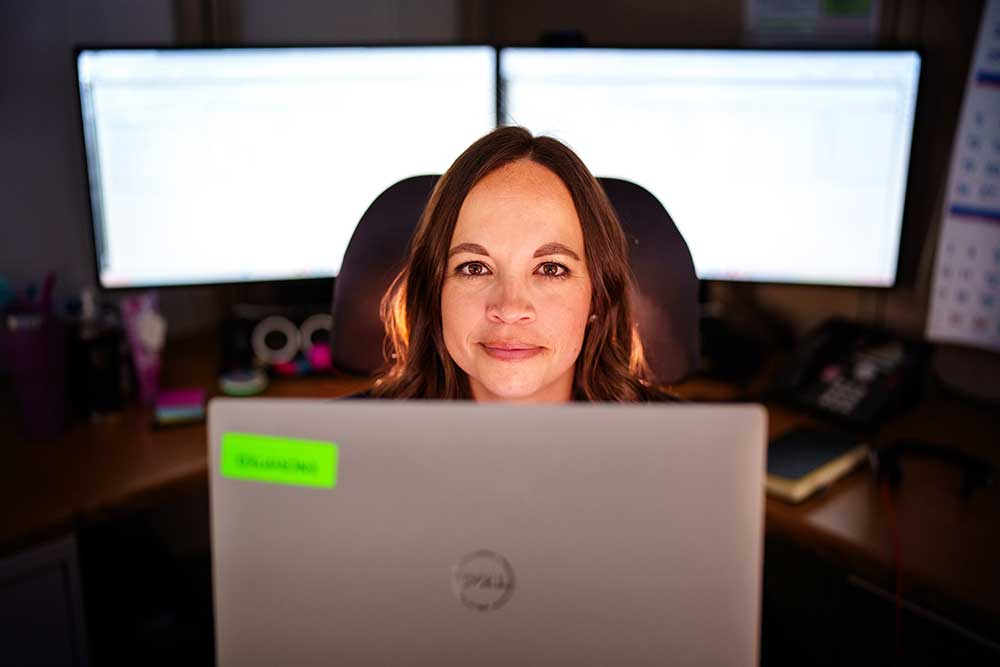Configuration Management group brings standardization to managing programs in the digital age

A new team at Sandia is helping to more consistently track why and when important changes are made during the design and development of nuclear deterrence systems. It takes an average of 10 years to develop a system from design to production. That means a lot of decisions and changes are made along the way.
Amber Cantwell leads the nuclear deterrence configuration management team, formed in April 2022 to centralize resources and unify Sandia’s approach to configuration management, which is a critical system engineering process.
“Configuration management ensures that the design intent equates to the product we’re delivering. In simple terms, it’s a digital record book that explains why we made specific decisions and what those are,” Amber said. “It ensures that what you designed and what you built are identical and meet requirements.”
Storage of artifacts, such as technical decisions, pointers to test data, design information and safety records, is also a component of configuration management.
Optimizing configuration management
Configuration management has been used since the early days of developing nuclear deterrence systems, but that information was captured and stored in various ways. Now, Sandia’s new team is optimizing how configuration management is applied across modernization programs.
A centralized repository that supports real-time collaboration is one key to optimization. The other is consistent storage of digital artifacts that will be available through the lifetime of the system. The use of the repository and standardization of processes enable consistency across weapon programs.
“We have a more consolidated approach to how we’re managing information and keeping track of associated linkages as designs evolve,” Amber said. “As an example, if we identify an issue with a component, using the centralized repository, we could quickly identify which other systems are using that component. That in turn allows us to let the production agencies know more quickly what we’ve identified.”
Digital engineering ecosystem
The centralized repository and systems engineering processes will maintain traceability of a product’s design, requirements, qualification evidence and delivered configurations throughout its lifecycle.

The configuration management team contributes to the digital engineering ecosystem by helping create the framework for managing the design definition and tool support to help implement it and validate it with other partners.
The configuration management team has about 15 members. The team partners with others, such as design and weapon engineers, surveillance and sustainment teams and information managers to audit traceability of information, ensuring the full lifecycle of data is captured.
“The repository will help improve collaboration across programs and with partners. Having accurate and timely data available is essential as programs are leveraging lessons learned and documenting system designs,” Amber said.
Optimizing configuration management practices of deterrence systems will provide enduring information and help build the digital thread. “We can store a requirements document as a digital artifact in the central repository, along with the system design and how it was eventually built. It will provide the full story of that system, adding to the digital thread,” Amber said.
Knowledge preservation
Another benefit of configuration management is that it helps preserve knowledge in a complex and quickly evolving environment as new systems are developed or existing systems in the stockpile are updated.
“We used to have engineers who would spend their entire 30-year career on one program. You could go to them and ask why a certain decision was made. They could refer to their desktop, notebook or binder and say, ‘Here’s why we did what we did,’” Amber said.
Now, it’s rare for an engineer to stay on one program for their entire career. As the workforce changes, Amber’s team is working toward a standardized approach to configuration management to maximize knowledge preservation from previous programs while participating in the transition into the digital engineering ecosystem for future systems.
“I want our successors to see when and why decisions were made. We’re accelerating our ability to move forward because we have a more consolidated approach and framework for managing technical information as nuclear deterrence systems evolve,” Amber said. “Things change over time and understanding why that happened is important.”
Embracing change in modern engineering
Sandians, such as Kajal Patel and her colleagues, are embracing the rigor Amber’s team is applying to configuration management.
“The group has done an excellent job in executing the configuration management work for the W87-1 program in a collaborative and efficient manner, which significantly contributed to meeting program goals,” Kajal said.
The team is also working on stockpile projects to apply additional rigor and consistency. “Amber’s team has done an excellent job helping surveillance testers incorporate a configuration management structure that is consistent with those used by the modernization programs. They’ve worked diligently to understand our unique needs and have been very responsive when questions arise,” said Andrew Garner, a manager in stockpile surveillance.
The configuration management activities align with one of the Labs’ main goals for fiscal year 2024, which is to “lead in modern engineering.”
Amber says establishing common configuration management tools and maturing processes is helping demonstrate product readiness and ensure additional progression in advancing the digital engineering ecosystem.